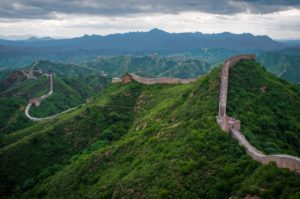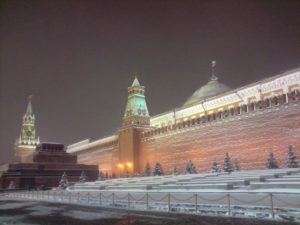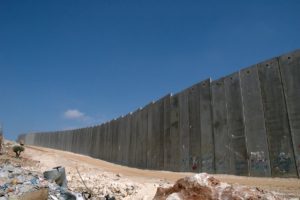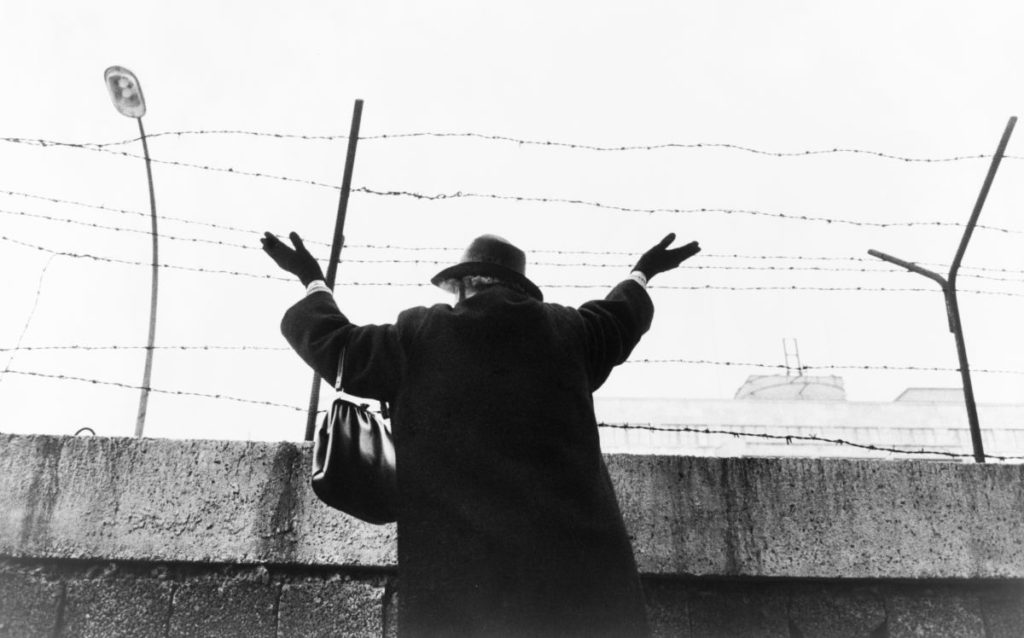Today everyone knows what you mean when you simply begin a conversation to talk about “The Wall” — that of course references the Wall President Trump has repeatedly promised to build between the U.S. and Mexico to eliminate most of illegal crossings into the U.S. from Mexico.
We are constantly bombarded by leftist talk show hosts, Democrat politicians, and even a few Republicans with an emphatic statement: “No wall on the U.S. southern border will stop illegals coming into the U.S. And thinking so is just plain lunacy.” Of course the “lunacy” reference is pointed directly at the President who some say is actually mentally deficient. (But that’s another story for another time.)
In all the talk and debate about “The Wall,” it seems important to take this discussion out of the political arena and find some facts that will either prove or disprove historically how such a wall (or one similar) has actually worked in either keeping people out or keeping people in. Believe it or not, there are quite a few historical examples. Let’s pull the plug on “The Wall” emotions and try to find some factual context on which to make a non-emotional decision: should we or should we not build “The Wall.”
Jericho
The Biblical Wall of Jericho is one of the earliest examples of a defensive wall constructed by a community. Two sets of walls found in Jericho, and excavated by Ernest Sellin and Carl Watzinger, date back to anywhere between 1950 BC and 1550 BC. But the earliest evidence of a wall is believed to date to 7825 BC. The most famous Wall of Jericho, however, is the one mentioned in the Biblical account of the wall that the Israelites destroyed using the Ark of the Covenant (Book of Joshua). The wall is believed to have stood five feet thick, anywhere between 12 and 17 feet tall, surrounded by a 27-footwide and nine-foot deep ditch. It is hypothesized that the Wall of Jericho was constructed not only for defensive purposes, but also to protect the city from floods and for ceremonial usages. The Tower of Jericho may have been a means to draw individuals into the city. After the wall came tumbling down, according to biblical text, every man, woman, and child in the city of Jericho was put to the sword save for the family who harbored Israeli spies during the siege.
Hadrian’s Wall
Hadrian’s Wall, constructed between 122 AD and 128 AD for inspection by the Roman Emperor Hadrian, was a reaction to rebellions that Rome experienced by the provincial peoples of Britannia. The wall stood an impressive ten feet wide, 16 to 20 feet tall, and 73 miles long, following the course of the Tyne River. Historians disagree on the explicit purpose of Hadrian’s Wall, though it is widely considered to have been an attempt at curbing immigration as well as providing an opportunity to tax anyone crossing the wall. In this endeavor, Hadrian’s Wall was a success. Even when a different wall was constructed during the reign of Antoninus Pius farther north (the Antonine Wall), the Romans opted to permanently keep its legions along Hadrian’s Wall. Until the end of Roman rule in the province of Britannia, Hadrian’s Wall stood strong. When Rome lost its hold on the province, however, the wall was largely dismantled for parts by the “barbarian” populations against whom it had stood.
The Great Wall of China
 The Great Wall of China was not always so great. It began as a series of independently constructed walls as long ago as the 7th century BC. Over time, they became connected into a single vast wall spanning a staggering 5,500 miles during the Ming Era. The wall’s military purpose was to defend China against the multitude of invaders that plagued the borderlands – primarily the Mongols and the Manchu. But the walls provided other economic and social benefits for China, allowing the Chinese to enforce economic duties along the Silk Road as well as decrease the number of immigrants from Central Asia. As a means of maintaining control over citizens of China and their trade, the Great Wall was quite successful. However, the wall failed to keep invaders out entirely. Genghis Khan and his Mongol warriors, the Liao, the Jin, and the Manchus all managed to invade and take territory across the wall. Though this wall has never been altogether destroyed, its maintenance was, and is, such a colossal undertaking that large sections of it have fallen into disrepair over time.
The Great Wall of China was not always so great. It began as a series of independently constructed walls as long ago as the 7th century BC. Over time, they became connected into a single vast wall spanning a staggering 5,500 miles during the Ming Era. The wall’s military purpose was to defend China against the multitude of invaders that plagued the borderlands – primarily the Mongols and the Manchu. But the walls provided other economic and social benefits for China, allowing the Chinese to enforce economic duties along the Silk Road as well as decrease the number of immigrants from Central Asia. As a means of maintaining control over citizens of China and their trade, the Great Wall was quite successful. However, the wall failed to keep invaders out entirely. Genghis Khan and his Mongol warriors, the Liao, the Jin, and the Manchus all managed to invade and take territory across the wall. Though this wall has never been altogether destroyed, its maintenance was, and is, such a colossal undertaking that large sections of it have fallen into disrepair over time.
Moscow’s Kremlin Walls
 When Moscow was founded in the 12th century it was fortified only by wooden fences and rudimentary walls. However, under Tsar Ivan I, Muscovy began a concerted project to construct a wall around the Kremlin made of oak (1339-1340). In 1365, these walls were razed and a new wall made of limestone was constructed under the reign of Dmitrii Donskoi in the late 14th century. These walls were never toppled though they were largely redone and renovated by Tsar Ivan III (or Ivan the Great) in the late 15th century. This version of the Kremlin wall, finished in 1495, was over a mile in length varied in height from 16 feet to over 60 feet and in thickness from 11 feet to over 20 feet. The Kremlin walls failed, however, to keep Batu Khan, the Poles, and Napoleon out of Moscow despite never being physically destroyed. While the Kremlin’s walls originally served a solely defensive purpose, they stand today as a powerful symbol of Russian national identity.
When Moscow was founded in the 12th century it was fortified only by wooden fences and rudimentary walls. However, under Tsar Ivan I, Muscovy began a concerted project to construct a wall around the Kremlin made of oak (1339-1340). In 1365, these walls were razed and a new wall made of limestone was constructed under the reign of Dmitrii Donskoi in the late 14th century. These walls were never toppled though they were largely redone and renovated by Tsar Ivan III (or Ivan the Great) in the late 15th century. This version of the Kremlin wall, finished in 1495, was over a mile in length varied in height from 16 feet to over 60 feet and in thickness from 11 feet to over 20 feet. The Kremlin walls failed, however, to keep Batu Khan, the Poles, and Napoleon out of Moscow despite never being physically destroyed. While the Kremlin’s walls originally served a solely defensive purpose, they stand today as a powerful symbol of Russian national identity.
Wall Street’s Walls
 I bet you never thought about THESE walls. In the seventeenth century, the wall on what is now Wall Street created a barrier between the Dutch and their Native American neighbors. The fortified wall stretched from Pearl Street, which was one shoreline of Manhattan at the time, to the other shoreline, modern day Trinity Place. During this period, Wall Street was also the marketplace where owners could hire out their slaves. The rampart was removed in 1699, but the corners of Pearl and Wall Street remained a location for trade and business. After the Buttonwood Agreement in 1792 that organized a traders’ association—which was the origin of the New York Stock Exchange—businesses slowly flocked to the area, pushing out residents in the nineteenth century, and the Wall Street of today was born.
I bet you never thought about THESE walls. In the seventeenth century, the wall on what is now Wall Street created a barrier between the Dutch and their Native American neighbors. The fortified wall stretched from Pearl Street, which was one shoreline of Manhattan at the time, to the other shoreline, modern day Trinity Place. During this period, Wall Street was also the marketplace where owners could hire out their slaves. The rampart was removed in 1699, but the corners of Pearl and Wall Street remained a location for trade and business. After the Buttonwood Agreement in 1792 that organized a traders’ association—which was the origin of the New York Stock Exchange—businesses slowly flocked to the area, pushing out residents in the nineteenth century, and the Wall Street of today was born.
Berlin Wall
Officially known on the East German side as the Anti-Fascist Protection Rampart, this infamous wall is an extraordinary example of a society’s attempt to halt the movement of its own people, separating Germans (and often families) into two different worlds. The Soviet, eastern side of Germany had a vested interest in keeping out the ideals, culture, and economic models of the West during the Cold War. Upon completion, the wall stood 87 miles long with another wall running parallel to the original just 300 feet behind it. In its infancy the wall was primarily made of barbed wire but over time it evolved into an extremely formidable border. Concrete, barbed wire, and a no man’s land of empty space between the walls makes this barrier system one of the most daunting walls in human history. It was not to persist, however. In October of 1989, the East German government decided to allow some citizens to emigrate to West Germany, which resulted in a swarming of the wall checkpoints by thousands of citizens. And on November 9, the Berlin Wall was officially opened.
Korean Demilitarized Zone “Walls”
Snaking across the width of the Korean peninsula, this wall creates a 160-mile-long, two-and-a-half-mile-wide buffer zone between North and South Korea. The DMZ was constructed along the 38th Parallel and is considered to be the most heavily militarized border in the entire world. Incidents and incursions continue along the DMZ, although recent peace talks have begun ever so slightly to depressurize the border. The two countries have agreed to allow families divided between Northern and Southern halves of the border to reunite in a rare effort at cohabitation. Such efforts do not erase recent episodes of landmine explosions, cross-boundary rocket fire, and propaganda radio broadcasts, however, but may ease tensions along the political powder keg that is the DMZ. Since the Korean conflict ended in 1953 in a truce, the state of war between Seoul and Pyongyang continues to validate the existence of the world’s most heavily guarded border. This wall stands as perhaps the most effective anti-migrant fortification in all of human history. It has kept the populations of two independent nations almost entirely secluded from one another for over six decades.
West Bank Barrier
 This monster of a wall currently runs along the 1949 Armistice Agreement Line (or the Green Line) that separates Israel from the territories of the West Bank. This barrier runs a staggering 330 feet in width at certain places and up to 26 feet high. The primary reasons for the construction of this barrier (which began in approximately 2000) are contentious. The Israeli government states that the wall is being built to protect Israeli citizens from suicide bombers and radical terrorist organizations. Opposition groups argue that the barrier is a land-grab disguised as a defensive perimeter. Though construction on the wall has not yet been completed, some reports indicate that there has been a marked decline in the number of suicide attacks within Israel.
This monster of a wall currently runs along the 1949 Armistice Agreement Line (or the Green Line) that separates Israel from the territories of the West Bank. This barrier runs a staggering 330 feet in width at certain places and up to 26 feet high. The primary reasons for the construction of this barrier (which began in approximately 2000) are contentious. The Israeli government states that the wall is being built to protect Israeli citizens from suicide bombers and radical terrorist organizations. Opposition groups argue that the barrier is a land-grab disguised as a defensive perimeter. Though construction on the wall has not yet been completed, some reports indicate that there has been a marked decline in the number of suicide attacks within Israel.
The Pakistan Wall
Yep. Believe it or not, Pakistan is building a wall right now between their country and Afghanistan. After decades of unsuccessfully controlling the flow of terrorists and criminals who quietly slip back and forth across the porous 1,500-mile border between the two countries, evading capture, the Pakistan government chose to stop the illegal and deadly border crossings with a wall. The wall is not concrete, but consists of a comprehensive border system that includes two layers of 12-feet-tall barbed-wire fencing, surveillance cameras, solar lights, an intrusion detection system, and hundreds of manned forts and thousands of observation posts. It is scheduled to be completed by the end of 2019.
Summary
Wow! Not a single detractor of President Trump’s wall even mentions a single historical wall that in most cases has been very successful at doing one of two things: keeping people in, or keeping people out. With the furor surrounding the funding and construction of “The Wall,” I thought it timely to simply ask a few questions for all to ponder as the historical walls above and their impact from their construction are being discussed. These questions all apply to not any wall but “The Wall:”
- If such walls have pretty much worked historically, why the fuss by many to not just fund “The Wall,” but to with all the energy that can be mustered actively campaign to stop its construction? Surely NO American thinks spending $25 Billion on a border wall even though very expensive is too much for the U.S. to spend. That’s about 2 hours worth of government spending today!
- If the amount of money to build “The Wall” is not really unreasonable, do these wall haters have ulterior motives for their hate? If so, what could those motives possibly be?
- Why do these detractors want so desperately to apparently keep the southern border open that allows millions of illegals into the U.S. whose presence here is many cases is dangerous but in EVERY case costs American taxpayers billions of dollars and millions of jobs?
I’ll let you answer these three questions for yourself. But a very smart man told me when there is ever a political conundrum that needs its reason to be ferreted out, you can always “follow the money.” And in today’s political world, one does not have to follow the money, just follow the power. Power brings with its accumulation EVERYTHING — including money.
My two cents? Democrats don’t want “The Wall” because they fancy all those Spanish speaking illegals becoming citizens, obtaining the right to vote, and claiming those millions of voters as part of “their” followers, thus getting all those votes.
Before you decide to slap me around for that negative opinion of Democrats, consider this: that mindset has certainly worked for them before. Remember: Democrats could NOT in Congress pass the Civil Rights Act. Republicans passed it! Democrats stood against giving blacks the right to vote in 1964. Democrats started the Ku Klux Klan. Democrats devised today’s Welfare Program to make it financially unfeasible for African American couples to marry and live together, thus creating broken single-parent black homes. All of this was to force African Americans to feel obligated to……DEMOCRATS.
You can bet Dems are counting on the same situation with these illegals. And Donald Trump is probably the first president to recognize it AND BE WILLING TO FIGHT TO KEEP IT FROM HAPPENING!

